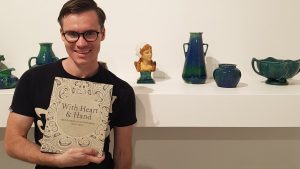By Helen Gregory
‘Will you go through our collection to see what you can find for an exhibition on the 1890s floods in Brisbane?’ was an invitation too tempting to resist. Flooding was in all our minds early in 2011 when the State Library of Queensland was planning its ‘Floodlines’ exhibitions. The exhibition on the 2010-2011 floods which inundated vast swathes of Queensland was planned to be a high tech exposition, using the latest in electronic wizardry to communicate the horrible experiences endured by many people in Queensland’s ‘summer of sadness’.
The nineteenth century exhibition was to explain earlier floods and to remind Queenslanders – particularly Brisbane people’ – that flooding has been very much a part of life in southern Queensland. But it was always possible that the nineteenth century exhibition could do more than that. For people like me who had grown up in Brisbane, ‘the 1893 flood’ seemed to be help up as a measuring stick against which all other disasters could – or even should – be understood.
‘The 1893 flood’ is, however, something of a shibboleth. There were four floods in 1893 – two big ones and one small one in February and a moderate flood event in June. These followed quickly on a flooding disaster in 1890 and yet another in 1887. It seemed, therefore, important to probe the apparent elision of several events into ‘the 1893 flood’. It was important to try to portray a sense of what Brisbane was actually like after the years of rapid growth in the 1880s boom years, quite similar, in fact, to the boom and growth years immediately preceding the 2011 floods.
Floods are ruinous events: lives are lost, homes and businesses are devastated, jobs disappear – many of those which remained after the 1890s depression was well and truly biting – infrastructure is ruined. Shock is pervasive. It was necessary to develop a picture of what actually happened in the nineteenth century floods, but to do in a way which also personalised experience. The creation of ‘the 1893 flood’ catchphrase seemed to have had a great deal to do with community memory. It would, therefore, be important to try to capture the way in which the community experienced flooding, interpreted it and remembered it. Dealing with future flood events was a hot topic during 2011 when the Commission of Inquiry was hearing evidence and preparing its reports. What happened to the recommendations of inquirers after the nineteenth century floods was also a pertinent theme to pursue.
Would the John Oxley Library have the materials to cover this canvas? Oh, yes, it did: there were thousands of items from volumes of photographs to scrappy telegrams to august published reports. Selection was by far the most challenging issue. The Philip Bacon gallery on the fourth floor of the State Library building could accommodate only about 70 individual items.
It is, therefore, an impressionist display. Plans showing the spread of the city in the late 1880s and the types of advertising of new housing estates in flood-prone areas begin the journey into images showing that the 1887 and 1890 floods were, indeed, severe. Then comes a magically-conserved frail plan which showed the extent of the 1893 inundations in the river’s flood plain and the flood plains of suburban creeks and the stories of people whose homes and livelihoods were lost. A J Hockings’s gardening books seem, for a moment, out of place, until one realises that this former mayor of both Brisbane and South Brisbane lost his home and his extensive plant nursery in the 1890 flood. His grand-daughter, Eleanor Bourne, left a hand-written account of her experience in the 1893 flood in her home which stood almost exactly on the site of the State Library. A few of his publications were intended to give an additional dimension to the life and work of the government meteorologist, Clement Wragge … and so it went on.
Recovery seemed appropriately covered by images of people washing flood damaged clothes, advertisements for fund-raising events and the books of the Central Flood Relief Fund. An advertisement for the sale of the Orleigh Estate and an image showing that not one house remained after February 1893 helped to create an understanding that, sometimes, lessons are learned. Most of the Orleigh Estate is now parkland. Paintings in oils and watercolours, a novel by the marvellous Dr Thomas Pennington Lucas, inventor of Pawpaw Ointment, poems and short stories written in subsequent decades helped to convey a sense of memory going on and on as did three audio excerpts from the great-grandsons of men affected by the floods: HC Stanley, whose Albert railway bridge was destroyed immediately in front of his own home, James Love, who opened his business a short time before the 1890 flood and A J Hockings, the businessman-mayor.
Reports of various inquiries have generated considerable interest among exhibition visitors, particularly the 1899 plan in Colonel Pennycuick’s report which was given life almost a century later in the 1980s as the Wivenhoe Dam. There is also amusement that Brabant and Co took their claim for compensation against the Queensland government to the Privy Council. Their Lordships seemed much more sympathetic than the Queensland courts.
Curating this exhibition was a journey of discovery for an historian with a life-long fascination with the Brisbane in all its travails and wonders.


